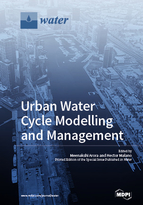Urban Water Cycle Modelling and Management
A special issue of Water (ISSN 2073-4441). This special issue belongs to the section "Urban Water Management".
Deadline for manuscript submissions: closed (30 September 2017) | Viewed by 105609
Special Issue Editors
Interests: integrated urban water management; fluoride in drinking water and its health impacts; fluoride and arsenic removal from groundwater; contaminant transport and remediation in land and groundwater
Special Issues, Collections and Topics in MDPI journals
Interests: irrigation management; water resources planning; climate change adaptation; urban water cycle modelling and management; sustainability; urbanization; water policy and environmental management
Special Issues, Collections and Topics in MDPI journals
Special Issue Information
Dear Colleagues,
Many major cities of the world face challenges arising from growing and urbanizing populations, a changing climate, and an increase in the frequency of extreme weather events. Existing centralized water services, operating at, or close to, full capacity, are not sufficient to cope with the associated increase in water demand. Replacing the entire centralized infrastructure is very difficult within the existing environmental and economic constraints. Water services, in such case, can be provided through the integration of decentralized and centralized systems, which are referred to as hybrid water supply systems.
The premise of hybrid water supply systems is that the provision of alternative water sources at local scales can extend the capacity of existing centralized water supply infrastructure. However, it is important to recognize the challenges associated with diversification of water source portfolios, such as increased energy intensity and greenhouse emission (GHG) of urban water systems, overall cost, community acceptance and livability, altered flow and composition of wastewater and storm water impacting on the effectiveness and performance of existing infrastructure. Undertaking the diversification of water sources, however, implies a detailed understanding and capacity to analyse the performance of the entire water cycle. This Special Issue invites papers that deal with comprehensive modelling of urban water cycle and its management as a dynamic system.
Dr. Meenakshi Arora
Prof. Dr. Hector M Malano
Guest Editors
Manuscript Submission Information
Manuscripts should be submitted online at www.mdpi.com by registering and logging in to this website. Once you are registered, click here to go to the submission form. Manuscripts can be submitted until the deadline. All submissions that pass pre-check are peer-reviewed. Accepted papers will be published continuously in the journal (as soon as accepted) and will be listed together on the special issue website. Research articles, review articles as well as short communications are invited. For planned papers, a title and short abstract (about 100 words) can be sent to the Editorial Office for announcement on this website.
Submitted manuscripts should not have been published previously, nor be under consideration for publication elsewhere (except conference proceedings papers). All manuscripts are thoroughly refereed through a single-blind peer-review process. A guide for authors and other relevant information for submission of manuscripts is available on the Instructions for Authors page. Water is an international peer-reviewed open access semimonthly journal published by MDPI.
Please visit the Instructions for Authors page before submitting a manuscript. The Article Processing Charge (APC) for publication in this open access journal is 2600 CHF (Swiss Francs). Submitted papers should be well formatted and use good English. Authors may use MDPI's English editing service prior to publication or during author revisions.
Keywords
- Urban water cycle
- Distributed systems
- alternative water supply sources







